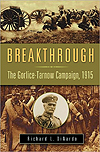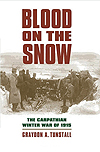

Blood on the Snow: The Carpathian Winter War of 1915, by Graydon J. Tunstall, University Press of Kansas, Lawrence, 2010, $29.95
Breakthrough:The Gorlice-Tarnow Campaign, by Richard L. DiNardo, Praeger, Santa Barbara, 2010, $44.95
World War I in the East, long a dormant research field, has recently flourished. Authors Tunstall and DiNardo make major contributions in these closely related monographs that combine for a major analytical conclusion. In contrast to the clearly defined, 500-mile “edge city” of the Western Front, war in the Eastern theater was at best semimodern and tended to devolve rapidly. Tsarist Russia and Habsburg Austria-Hungary were only partially industrialized and were politically and administratively retrograde in 1914. The most up-to-date thing about them were their armies. And that veneer stripped away in the war’s first weeks. By January 1915, when Tunstall’s book begins, the peacetime officer corps had been destroyed, the trained cadres annihilated, the stocks of modern weapons and ammunition drawn down to near zero. The armies that faced each other in the white wilderness of a Carpathian winter comprised, at best, marginally competent officers and men. The result was a near-mindless death grapple focusing on hamlets no one had ever heard of. Deaths from exposure matched and exceeded deaths from shells and bullets. Men were regularly reported as having been eaten by wolves.
Tunstall reconstructs this military aberration through his mastery of relevant archives, in a dispassionate tone that conveys the battlefield horrors more clearly than could any number of descriptive adjectives. DiNardo picks up the story in spring 1915, when the Germans committed major forces to what seemed a situation only needing a judicious application of Teutonic efficiency to be remedied. It took them months to move enough men and munitions into a promising sector. But on May 2, 1915, the Germans blew open a 20-mile mile wide gap in the front between the hamlets of Gorlice and Tarnow.
DiNardo masterfully presents the plan and its execution, both long-overlooked triumphs of what was still the finest army in Europe. He is even more successful in demonstrating the factors that limited Gorlice-Tarnow to a breakthrough, as opposed to a breakout. Obviously, the technology of exploitation was insufficiently developed. But arguably more important, the infrastructure of the Gorlice-Tarnow region, and by extension the entire Eastern theater, was too primitive to enable effective employment of the means that did exist.
Tunstall and DiNardo demonstrate definitively that, in the words of German Chief of Staff General Erich von Falkenhayn, “The East [gave] nothing back”—nothing but chaos and revolution, as exhausted armies and exploited peoples came to hate their own governments more than they feared their enemies.
—Dennis Showalter




